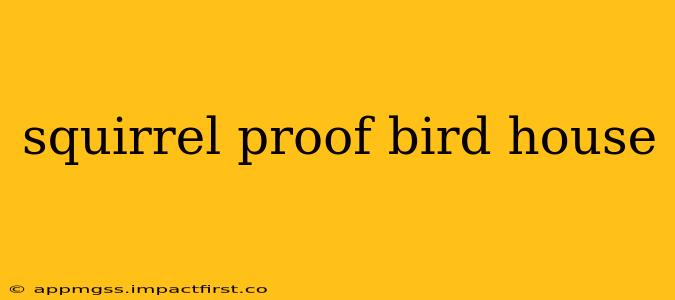Squirrels. Those adorable, bushy-tailed bandits. While charming to watch, they can be a significant nuisance for bird enthusiasts, often raiding birdhouses intended for feathered friends. Building or buying a truly squirrel-proof birdhouse requires understanding their behavior and employing effective deterrents. This comprehensive guide will delve into the best strategies and designs to keep squirrels out and birds happily nesting.
What Makes a Birdhouse Squirrel-Proof?
The key to a squirrel-proof birdhouse is to design it with features that exploit squirrels' physical limitations and behavioral patterns. Squirrels are larger, stronger, and more agile climbers than most birds. Therefore, the design must make accessing the nesting cavity significantly more difficult for squirrels while remaining easily accessible for the intended bird species.
How to Deter Squirrels from Birdhouses: A Multi-pronged Approach
Successfully keeping squirrels out of birdhouses often requires a combination of strategies:
1. Choosing the Right Location
- Height: Place the birdhouse high up on a sturdy pole or tree branch, well beyond the reach of a squirrel's typical jumping distance. At least 8-10 feet is recommended, even higher for particularly persistent squirrels.
- Accessibility: Avoid placing the birdhouse near overhanging branches or other structures that could provide squirrels with easy access. Ideally, choose a location that is exposed and difficult for them to climb.
2. Birdhouse Design Features
- Small Entrance Hole: The most crucial factor. A small entrance hole, sized appropriately for the target bird species, prevents larger squirrels from entering. Research the specific size needed for the bird you wish to attract. A smaller opening is your first line of defense.
- Baffles: Metal or plastic cone-shaped baffles placed below the birdhouse on the supporting pole create a slippery, difficult-to-climb surface for squirrels. These act as a physical barrier, deterring them from reaching the nesting cavity.
- Smooth Pole: Avoid rough-textured poles that squirrels can easily grip. A smooth metal pole is best, making it nearly impossible for them to climb.
- Strong Construction: The birdhouse itself needs to be sturdy enough to resist the squirrels' attempts to pry it open or pull it apart. Use strong materials and secure all joints.
3. Additional Deterrents
- Predator Guano: Some bird enthusiasts use predator guano (scat) around the base of the pole. The smell might deter squirrels, though its effectiveness varies.
- Shiny Objects: Hanging shiny objects near the birdhouse can also startle squirrels and make them think twice before approaching. However, this is less reliable than structural deterrents.
Frequently Asked Questions (FAQs)
What size entrance hole is best for a squirrel-proof birdhouse?
The ideal entrance hole size depends entirely on the bird species you want to attract. Research the specific needs of your target bird before drilling the hole. Remember, a smaller opening that fits the bird but excludes squirrels is key.
Do squirrel guards really work?
Yes, when properly installed and designed, squirrel guards (baffles) are highly effective. They create a physical barrier that prevents squirrels from accessing the birdhouse.
Can I make my own squirrel-proof birdhouse?
Absolutely! With careful planning and the right materials, building your own squirrel-proof birdhouse can be a rewarding project. Ensure you accurately research the dimensions and features necessary for both the birds and to deter squirrels.
How high should I hang a birdhouse to keep squirrels away?
Aim for at least 8-10 feet, but higher is better, especially if squirrels are persistent in your area. The greater the height, the harder it is for squirrels to reach the birdhouse.
What materials are best for a squirrel-proof birdhouse?
Durable, weather-resistant materials are essential. Untreated wood (cedar or redwood) is a popular choice. Make sure all joints are securely fastened to withstand squirrel attempts to dismantle it.
By employing these strategies and understanding squirrel behavior, you can dramatically increase your chances of providing a safe and successful nesting habitat for your favorite birds while keeping those pesky squirrels at bay. Remember, persistence is key; sometimes, it may require experimenting with various techniques to find the perfect solution for your specific location and squirrel population.
